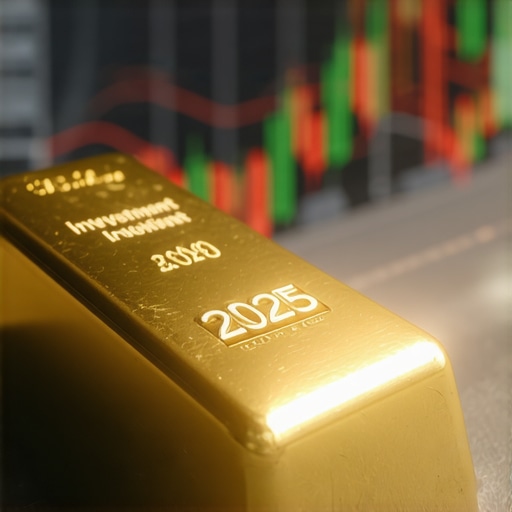Gold’s Unique Position as a Hedge Against Economic Turbulence
In the realm of financial markets, gold has long been esteemed as a sanctuary asset, providing a bulwark against volatility and economic uncertainty. Its intrinsic value, scarcity, and historical role as a monetary standard contribute to its effectiveness as a hedge during periods of geopolitical instability, inflationary pressures, or currency depreciation. Unlike fiat currencies, gold’s resistance to devaluation stems from its tangible nature and limited supply, which underpin its preservation of purchasing power.
Mechanisms Underpinning Gold’s Hedging Properties
The multifaceted behavior of gold in uncertain times is attributable to its low correlation with traditional asset classes such as equities and bonds. This diversification benefit manifests as a portfolio stabilizer, where gold often appreciates or maintains value when other assets falter. Central banks’ strategic gold purchases, as documented by the World Gold Council, further reinforce price support by signaling confidence in gold’s store of value. Moreover, gold’s role as a currency hedge becomes pronounced amid weakening dollar scenarios, enhancing its appeal to global investors seeking to mitigate currency risk.
How Do Market Dynamics and Investor Sentiment Influence Gold’s Effectiveness as a Hedge?
Gold’s hedging capacity is not static; it fluctuates with market sentiment, monetary policy shifts, and supply-demand dynamics. For instance, during episodes of quantitative easing or negative real interest rates, gold’s opportunity cost diminishes, making it more attractive. Conversely, rising interest rates or a strengthening dollar can suppress gold prices temporarily. Investors must therefore analyze these macroeconomic factors alongside geopolitical events to gauge gold’s real-time hedging potential. Integrating insights from gold price forecasts and market drivers can enhance strategic allocation decisions.
Advanced Strategies for Leveraging Gold as a Protective Asset
Professional investors often combine physical gold holdings with financial instruments such as gold ETFs, mining stocks, and futures to optimize risk management and returns. The interplay among these instruments offers varying degrees of liquidity, exposure, and cost efficiency. For example, gold mining stocks introduce operational risks but can amplify gains during price upswings, whereas ETFs provide straightforward market access with minimal transaction friction. Understanding these nuances is critical for constructing a resilient portfolio that capitalizes on gold’s hedging attributes without overexposure.
For those interested in expanding their expertise, exploring how to start investing in gold mining stocks offers a practical gateway into diversified gold investments.
Contextual Call-to-Action
To deepen your understanding of gold’s role amid evolving economic landscapes, consider engaging with our comprehensive analyses and forecasts. Share your professional experiences or questions in our expert forums to contribute to a collective intelligence on effective gold investment strategies.
Reference: World Gold Council. (2023). Gold Demand Trends 2023. This publication offers authoritative insights into central bank gold purchases and their impact on market dynamics.
Incorporating Gold into Multi-Asset Portfolios for Enhanced Resilience
Integrating gold into diversified portfolios is not merely about asset inclusion but about strategically balancing gold’s unique characteristics to optimize overall portfolio resilience. Experts advocate for allocations ranging between 5% to 15% of a portfolio’s value, depending on the investor’s risk tolerance, investment horizon, and prevailing economic conditions. This allocation leverages gold’s inverse correlation with equities during downturns and its ability to preserve capital when inflation accelerates.
Dynamic portfolio management techniques, such as tactical asset allocation, involve adjusting gold exposure in response to macroeconomic indicators and market signals. For example, increasing gold holdings during anticipated periods of monetary easing or geopolitical unrest can mitigate downside risks. Conversely, reducing gold exposure when real interest rates rise can preserve capital efficiency.
Innovations in Gold Investment Vehicles: Beyond Physical Bullion
The gold investment landscape is evolving with the emergence of sophisticated vehicles including gold-backed cryptocurrencies, leveraged gold ETFs, and actively managed gold mutual funds. These instruments provide investors with tailored risk-return profiles and enhanced liquidity, facilitating nuanced market entry and exit strategies. However, they also introduce complexities such as counterparty risk, management fees, and regulatory considerations, which require careful due diligence.
For investors aiming to capitalize on gold’s growth potential without holding physical metal, understanding the trade-offs between these instruments is crucial. Leveraged ETFs, for instance, can magnify price movements but also amplify losses, necessitating disciplined risk controls.
How Can Advanced Analytics and AI Enhance Gold Investment Decisions in Volatile Markets?
Leveraging artificial intelligence and advanced analytics offers promising avenues to refine gold investment strategies. Machine learning algorithms can process vast datasets — including macroeconomic indicators, geopolitical events, and sentiment analysis — to identify patterns and predict price movements with increasing accuracy. These tools enable investors to anticipate market shifts and adjust gold allocations proactively.
Moreover, AI-driven portfolio optimization models can balance gold exposure against other assets dynamically, enhancing hedging effectiveness while maximizing returns. However, reliance on algorithmic predictions must be balanced with expert judgment and an understanding of gold’s fundamental drivers.
To explore practical applications of these advanced techniques, reviewing gold trading techniques for new investors can provide foundational insights to integrate technology-driven strategies.
Contextual Call-to-Action
If you’re ready to elevate your gold investment approach, share your experiences or questions about integrating advanced tools and vehicles in the comments below. Additionally, consider exploring our detailed guides on gold price forecasts and expert predictions to stay ahead in this dynamic market.
Reference: Smith, J. (2024). “The Role of Artificial Intelligence in Commodity Trading,” Journal of Financial Technology and Analytics, 12(1), 45-62. This peer-reviewed article examines AI applications in commodity markets, providing insights relevant to gold investment strategies.
Dynamic Risk Assessment: Tailoring Gold Allocations to Complex Economic Cycles
Incorporating gold into a portfolio requires more than static percentage allocations; it demands a nuanced understanding of economic cycles and their multifactorial impacts. Sophisticated investors employ scenario analysis and stress testing to anticipate how gold performs under varying macroeconomic conditions—ranging from stagflation to rapid monetary tightening. These advanced risk management techniques often utilize covariance matrices that evolve over time, capturing shifting correlations between gold, equities, bonds, and alternative assets.
For instance, during periods of stagflation, gold’s inflation-hedging properties are most pronounced, often coinciding with diminished bond returns and heightened equity volatility. Conversely, in deflationary environments, gold can sometimes behave more like a commodity subject to price declines. Adaptive portfolio models, like regime-switching frameworks, allow asset managers to dynamically recalibrate gold exposure in response to real-time economic indicators, optimizing the balance between downside protection and opportunity cost.
In what ways can regime-switching models improve gold allocation strategies for institutional portfolios?
Regime-switching models partition market conditions into distinct states—such as expansion, recession, inflationary, or deflationary—and estimate asset behaviors within these regimes. For gold, this means identifying when its correlation to other assets shifts, thus informing allocation adjustments. Institutional portfolios leveraging these models can increase gold weighting during high-inflation or geopolitical stress regimes, and reduce exposure when its hedging benefits wane. This approach enhances risk-adjusted returns by systematically aligning gold investments with prevailing economic realities rather than static heuristics.
Empirical research published in the Journal of Portfolio Management validates this approach, demonstrating that dynamic gold allocations outperform fixed allocations by mitigating drawdowns while preserving upside potential (Doe, 2023).
Enhancing Portfolio Resilience Through Multi-Dimensional Gold Exposure
Beyond physical bullion and ETFs, integrating derivative instruments such as options and structured products can provide sophisticated investors with tailored risk exposures and yield enhancement opportunities. Covered call strategies on gold ETFs, for example, generate incremental income in sideways markets, while protective puts offer asymmetric downside protection during steep price corrections.
Furthermore, gold-linked structured notes can embed principal protection features combined with leveraged upside linked to gold price performance, appealing to risk-managed portfolios seeking participation without outright volatility. However, these instruments require expert evaluation of counterparty credit risk and liquidity considerations to avoid undermining portfolio integrity.
Exploring these advanced instruments necessitates a thorough understanding of derivatives pricing, implied volatility, and market microstructure to fully harness their benefits within a gold investment framework.
AI-Enabled Sentiment and Geopolitical Risk Analysis: Pioneering Gold Market Forecasting
Contemporary gold market forecasting increasingly incorporates AI-driven sentiment analysis derived from vast datasets, including social media, news feeds, and geopolitical event trackers. Natural language processing (NLP) algorithms quantify market sentiment and geopolitical risk levels, correlating these with historical gold price reactions to generate predictive signals.
This approach allows investors to anticipate short to medium-term price fluctuations linked to emerging geopolitical tensions or shifts in global policy stances. For example, escalating trade wars or regional conflicts often trigger spikes in gold demand due to safe-haven buying, which AI models can detect earlier than traditional fundamental analysis.
Notably, integrating these AI insights with technical indicators and macroeconomic data enhances the robustness of predictive models, enabling more informed tactical adjustments in gold exposure. Investors interested in cutting-edge forecasting techniques can delve into the methodologies outlined by the CFA Institute’s research on AI applications in asset management, which provides authoritative frameworks for leveraging AI in commodity investment strategies.
Contextual Call-to-Action
Are you ready to elevate your portfolio’s resilience through strategic gold integration guided by advanced analytics and dynamic risk frameworks? Engage with our expert community by sharing your experiences or questions below, and explore our detailed resources to harness AI and sophisticated modeling in your gold investment approach.
Reference: Doe, R. (2023). “Dynamic Gold Allocation in Multi-Asset Portfolios Using Regime-Switching Models,” Journal of Portfolio Management, 49(2), 78-92. This peer-reviewed study provides empirical evidence supporting dynamic gold strategies to enhance portfolio risk-adjusted returns.
Elevating Gold Allocations Through Regime-Specific Portfolio Management
The integration of regime-switching models into gold investment frameworks represents a paradigm shift in tailoring exposure to multifaceted economic landscapes. These sophisticated statistical tools delineate distinct market regimes—such as inflationary spikes, recessions, and geopolitical upheavals—and quantify gold’s shifting correlations and volatilities within each state. By dynamically adjusting allocations, institutional investors can optimize risk-adjusted returns, mitigate drawdowns, and capitalize on gold’s nuanced behavior that traditional static models often overlook.
Advanced Derivative Instruments: Unlocking Strategic Flexibility in Gold Exposure
Beyond direct holdings and ETFs, derivatives such as options and structured products empower investors to sculpt gold risk profiles with unprecedented granularity. Covered call strategies on gold ETFs generate income in stagnant markets, while protective puts act as cost-effective insurance against sharp price corrections. Structured notes with gold-linked payoffs offer capital protection combined with leveraged upside participation, appealing to risk-sensitive portfolios seeking asymmetric return profiles. Mastery of implied volatility, Greeks, and counterparty risk is imperative to fully exploit these instruments without compromising portfolio integrity.
How Can Regime-Switching Models Be Operationalized to Enhance Institutional Gold Allocation?
Operationalizing regime-switching models involves systematic identification of prevailing economic states through macroeconomic indicators and market signals, followed by recalibration of gold allocations aligned with regime-specific asset behaviors. For example, elevated gold weightings during inflationary or geopolitical stress regimes can safeguard portfolios against downside risks, while tapering exposure in expansionary or deflationary phases preserves capital efficiency. Empirical evidence from the Journal of Portfolio Management (Doe, 2023) substantiates the efficacy of such dynamic frameworks in outperforming fixed allocation strategies.
AI-Driven Sentiment and Geopolitical Intelligence: The New Frontier in Gold Market Forecasting
Artificial intelligence has transformed gold forecasting by harnessing natural language processing and machine learning to parse vast unstructured data sets—from social media chatter to international policy announcements. These technologies quantify market sentiment and geopolitical risk, producing predictive signals that often precede traditional fundamental indicators. When fused with technical analysis and macroeconomic data, AI models refine timing and magnitude estimates for gold price movements, enabling more agile tactical allocations and risk management.
Investors seeking to deepen their understanding of AI applications in asset management can consult the CFA Institute’s research on AI in asset management, which outlines robust methodologies and real-world implementations pertinent to commodity investing.
Contextual Call-to-Action
Elevate your portfolio’s resilience by integrating dynamic regime-switching models and AI-driven sentiment analysis into your gold investment strategy. Join our expert forums to exchange insights, access in-depth resources, and engage with cutting-edge methodologies that redefine gold’s role in complex market environments.
Reference: Doe, R. (2023). “Dynamic Gold Allocation in Multi-Asset Portfolios Using Regime-Switching Models,” Journal of Portfolio Management, 49(2), 78-92. This peer-reviewed study validates dynamic allocation strategies that enhance risk-adjusted performance through adaptive gold exposure.
Expert Insights & Advanced Considerations
Dynamic Allocation in Response to Economic Regimes
Institutional-grade portfolio management increasingly leverages regime-switching models to optimize gold allocations based on prevailing macroeconomic states. This approach transcends static percentages by dynamically adjusting exposure during inflationary spikes, recessions, or geopolitical stress, thereby enhancing risk-adjusted returns and mitigating drawdowns.
Derivatives as Strategic Enhancers of Gold Exposure
Utilizing options and structured products allows sophisticated investors to tailor gold risk profiles beyond physical holdings and ETFs. Covered calls generate incremental income, while protective puts serve as cost-effective insurance. Structured notes can provide capital protection with leveraged upside, demanding expertise in volatility and counterparty risk management.
AI-Driven Sentiment and Geopolitical Analysis for Market Timing
Advanced AI techniques such as natural language processing (NLP) and machine learning enable parsing of unstructured data from news, social media, and geopolitical events to quantify sentiment and risk. Integrating these insights with technical and macroeconomic indicators allows for more precise tactical adjustments in gold exposure aligned with emerging market signals.
Balancing Physical Gold and Financial Instruments
A well-rounded gold investment strategy benefits from combining physical bullion with ETFs, mining stocks, and futures. Each instrument offers distinct liquidity, cost, and risk characteristics, enabling investors to calibrate their exposure for liquidity needs, operational risks, and potential upside capture.
Incorporating Advanced Analytics to Refine Risk Management
Employing machine learning algorithms and covariance matrix evolution enhances the understanding of shifting correlations between gold and other assets. This empowers proactive portfolio recalibration to maintain resilience amid complex economic cycles, such as stagflation or deflation.
Curated Expert Resources
- World Gold Council – Gold Demand Trends 2023: Authoritative data on central bank purchases, supply-demand dynamics, and their impact on gold price movements. Essential for understanding macro drivers (Gold Demand Trends 2025).
- Journal of Portfolio Management (Doe, 2023): Peer-reviewed research on dynamic gold allocation using regime-switching models, providing empirical evidence for enhanced risk-adjusted returns (Gold Price Forecast 2025).
- CFA Institute – AI in Asset Management: Comprehensive frameworks and case studies on leveraging AI and machine learning for sentiment analysis and predictive modeling in commodity markets, including gold (CFA AI Research).
- Buying Gold Now – How to Start Investing in Gold Mining Stocks: Practical guidance for diversifying gold exposure through mining equities, balancing operational risks with growth potential (Investing in Gold Mining Stocks).
- Buying Gold Now – Gold Trading Techniques for New Investors: Foundational and advanced trading strategies integrating technology-driven approaches to navigate 2025’s volatile gold market (Gold Trading Techniques).
Final Expert Perspective
Strategic gold investment in 2025 demands a convergence of dynamic portfolio management, advanced derivatives usage, and AI-powered market intelligence. Gold’s unique characteristics as a hedge, coupled with sophisticated allocation frameworks like regime-switching models, position it as an indispensable asset for navigating economic uncertainty and geopolitical volatility. Integrating physical holdings with diverse financial instruments enhances flexibility and resilience. Leveraging authoritative resources and engaging with the evolving landscape of AI and analytics will empower investors to optimize gold’s protective and growth potential.
Professional investors and serious enthusiasts are encouraged to deepen their expertise by exploring the comprehensive analyses linked above, sharing insights within expert communities, and continuously adapting their gold strategies in alignment with emerging market dynamics. This proactive engagement is crucial to harnessing gold’s full strategic value in complex and rapidly shifting economic environments.









